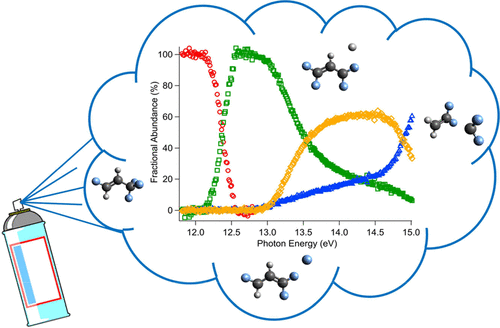当前位置:
X-MOL 学术
›
J. Phys. Chem. A
›
论文详情
Our official English website, www.x-mol.net, welcomes your feedback! (Note: you will need to create a separate account there.)
The Vagabond Fluorine Atom: Dissociative Photoionization of trans-1,3,3,3-Tetrafluoropropene.
The Journal of Physical Chemistry A ( IF 2.9 ) Pub Date : 2020-04-29 , DOI: 10.1021/acs.jpca.0c01804 Amelia W Ray 1 , Peter Weidner 1 , Andras Bodi 2 , Bálint Sztáray 1
The Journal of Physical Chemistry A ( IF 2.9 ) Pub Date : 2020-04-29 , DOI: 10.1021/acs.jpca.0c01804 Amelia W Ray 1 , Peter Weidner 1 , Andras Bodi 2 , Bálint Sztáray 1
Affiliation

|
The dissociative photoionization of trans-1,3,3,3-tetrafluoropropene (HFO-1234ze) was investigated by imaging photoelectron photoion coincidence (PEPICO) spectroscopy. From the threshold photoelectron spectrum (TPES), an adiabatic ionization energy of 10.91 ± 0.05 eV is determined and reported for the first time. Over a 4 eV wide range, internal-energy selected trans-1,3,3,3-tetrafluoropropene cations decay by three parallel dissociative photoionization channels, which were modeled using statistical theory. The 0 K appearance energies of CF2CHCF2 (H-loss, m/z 113), CFHCHCF2 (F-loss, m/z 95), and CH2═CF2 (CF2-loss, m/z 64) fragment ions were determined to be 12.247 ± 0.030, 12.66 ± 0.10, and 12.80 ± 0.05 eV, respectively. From the last, the heat of formation of neutral trans-1,3,3,3-tetrafluoropropene was determined to be -779.9 ± 9.7 kJ/mol. While the lowest-energy fluorine loss occurs directly, the first H-loss and CF2-loss channels involve both a fluorine- and a hydrogen-migration prior to dissociation. At higher internal energies, several other rearrangement pathways open up, which involve fluorine and hydrogen transfer and, through fluorine loss, lead to the formation of several additional isomeric allylic fragment ions.
中文翻译:

Vagabond氟原子:反式1,3,3,3-四氟丙烯的离解光电离。
通过成像光电子光子符合(PEPICO)光谱研究了反式1,3,3,3-四氟丙烯(HFO-1234ze)的离解光电离。根据阈值光电子能谱(TPES),确定并首次报告了绝热电离能10.91±0.05 eV。在4 eV的宽范围内,内部能量选择的反式1,3,3,3-四氟丙烯阳离子会通过三个平行的解离光电离通道衰变,并使用统计理论对其进行建模。确定CF2CHCF2(H损失,m / z 113),CFHCHCF2(F损失,m / z 95)和CH2CF2(CF2-损失,m / z 64)碎片离子的0 K出现能为分别为12.247±0.030、12.66±0.10和12.80±0.05 eV。从最后开始,确定中性反式1,3,3,3-四氟丙烯的形成热为-779.9±9.7 kJ / mol。虽然最低能量的氟损失直接发生,但第一个H损失通道和CF2损失通道在离解之前既涉及氟迁移又涉及氢迁移。在较高的内部能量下,打开了其他几个重排路径,这些路径涉及氟和氢的转移,并通过氟的损失导致形成了另外几个异构的烯丙基碎片离子。
更新日期:2020-04-02
中文翻译:

Vagabond氟原子:反式1,3,3,3-四氟丙烯的离解光电离。
通过成像光电子光子符合(PEPICO)光谱研究了反式1,3,3,3-四氟丙烯(HFO-1234ze)的离解光电离。根据阈值光电子能谱(TPES),确定并首次报告了绝热电离能10.91±0.05 eV。在4 eV的宽范围内,内部能量选择的反式1,3,3,3-四氟丙烯阳离子会通过三个平行的解离光电离通道衰变,并使用统计理论对其进行建模。确定CF2CHCF2(H损失,m / z 113),CFHCHCF2(F损失,m / z 95)和CH2CF2(CF2-损失,m / z 64)碎片离子的0 K出现能为分别为12.247±0.030、12.66±0.10和12.80±0.05 eV。从最后开始,确定中性反式1,3,3,3-四氟丙烯的形成热为-779.9±9.7 kJ / mol。虽然最低能量的氟损失直接发生,但第一个H损失通道和CF2损失通道在离解之前既涉及氟迁移又涉及氢迁移。在较高的内部能量下,打开了其他几个重排路径,这些路径涉及氟和氢的转移,并通过氟的损失导致形成了另外几个异构的烯丙基碎片离子。


























 京公网安备 11010802027423号
京公网安备 11010802027423号